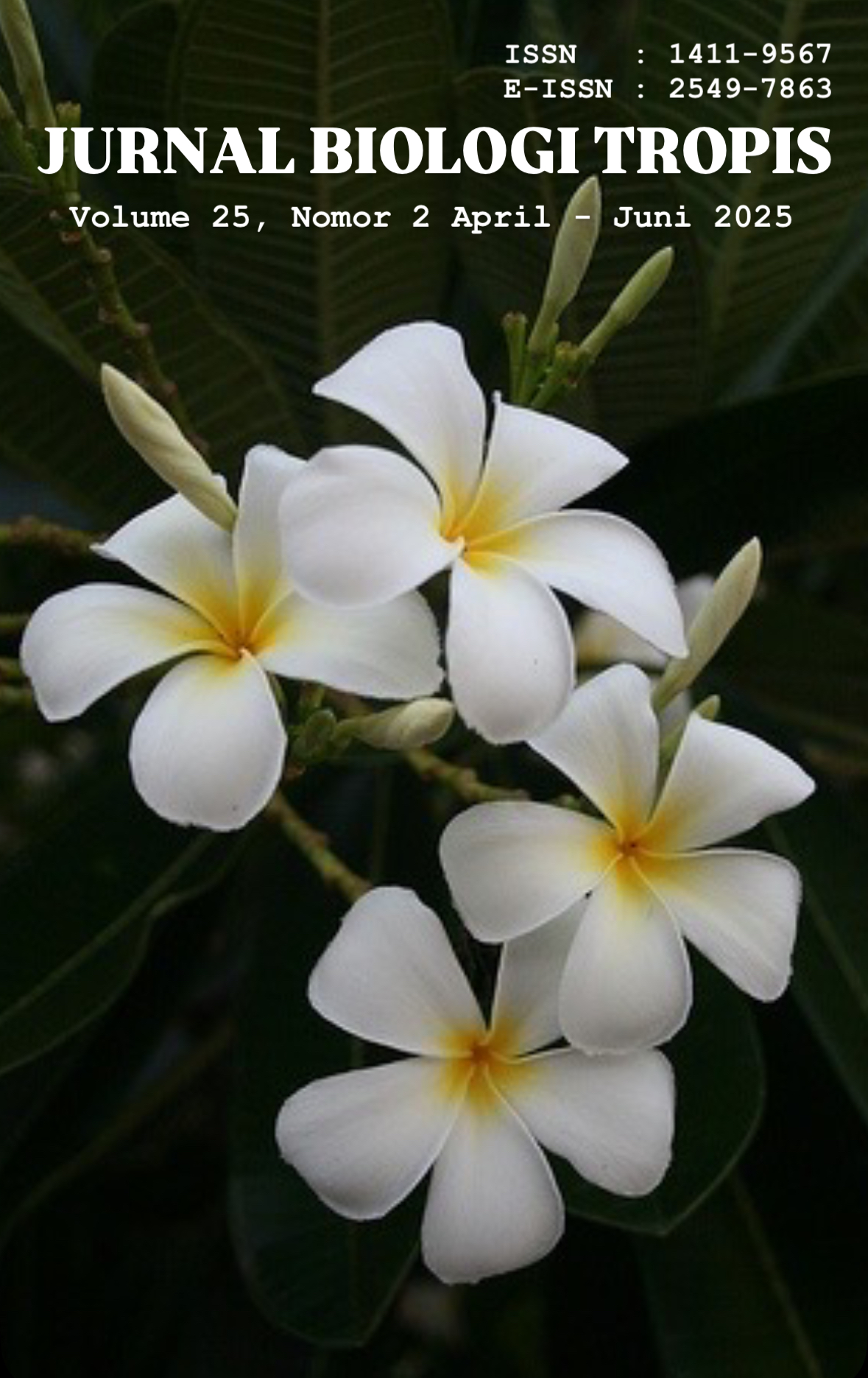Morphological Characteristics of Cucumber (Cucumis sativus L.) Leaves under Different Environmental Conditions
Authors
Ulfa Dwi Putri , Vauzia Vauzia , Moralita Chatri , Dezi HandayaniDOI:
10.29303/jbt.v25i2.8865Published:
2025-04-30Issue:
Vol. 25 No. 2 (2025): April-JuniKeywords:
Adaptation, cucumber, enviromental changes, morphology characters.Articles
Downloads
How to Cite
Downloads
Metrics
Abstract
Cucumber (Cucumus sativus L.) is a horticultural crop with high water content, low calories, and potential benefits as an antibiotic, lipid-lowering agent, and antioxidant. This Plant has great potential for cultivation, as it can be marketed both domestically and internationally. However, cucumber production remains relatively low and has declined from 2022 to 2023. This decrease is caused by several factors, one of which is changing environmental conditions. Therefore, the plant's ability to adapt to different environmental conditions becomes a crucial factor in the effort to develop cucumber cultivation. Based on this, the present study was conducted to investigate the morphological characteristics of cucumber leaves under different environmental conditions. This research was conducted from September 2024 to January 2025 in two different locations, namely Kota Padang and Kamang Magek. The method used in this study was a Completely Randomized Design (CRD) with 2 treatments and 20 replications. The data obtained were analyzed using a t-test at a 5% significance level. The results showed that there were significant differences in leaf length and the number of leaf vein branches between the two research locations. The average leaf length in Kota Padang was higher, at 12.21 cm, compared to Kamang Magek, which only reached 10.42 cm. In contrast, the average number of leaf vein branches in Kamang Magek was higher, at 14.65, compared to Kota Padang, which was only 13.3. Meanwhile, no significant differences were found in leaf width and petiole length between the two locations.
References
Badan Pusat Statistik. (2024). Statistik Tanaman Sayuran Indonesia 2023. Jakarta: Badan Pusat Statistik.
Bijarpasi, M. M., Shahraji, T. R., & Lahiji, H. S. (2019). Genetic variability and heritability of some morphological and physiological traits in Fagus orientalis Lipsky along an elevation gradient in Hyrcanian forests. Folia Oecologica, 46(1), 45-53. https://doi.org/10.2478/foecol-2019-0008
Daduto, G.M., Kaunang, Ch. L., Telleng, M.M., & Sumolang, C. I. J. 2020. Karakter Agronomi Sorgum Varietas Samurai Ii Fase Vegetatif Yang Ditanam Pada jarak Tanam berbeda. Zootec, 40 (2), 773-780. https://doi.org/10.35792/zot.40.2.2020.30408
Falster, D., Brännström, Å., Dieckmann, U., & Westoby, M. (2011). Influence of four major plant traits on average height, leaf‐area cover, net primary productivity, and biomass density in single‐species forests: a theoretical investigation. Journal of Ecology, 99. https://doi.org/10.1111/j.1365-2745.2010.01735.x.
Fan, X., Yan, X., Qian, C., Bachir, D., Yin, X., Sun, P., & , X. (2020). Leaf size variations in a dominant desert shrub, Reaumuria soongarica, adapted to heterogeneous environments. Ecology and Evolution, 10, 10076 - 10094. https://doi.org/10.1002/ece3.6668.
Gusti, H. (2017). Respon pertumbuhan dan produksi tanaman mentimun terhadap pemangkasan pucuk. In Proceedings of The 2th International Multidisciplinary Conference 2016. Vol. 1, No. 1. https://jurnal.umj.ac.id/index.php/IMC/article/view/1201
Harahap, W. N., Yuniasih, B., & Gunawan, S. (2023). Dampak La Nina 2021-2022 terhadap Peningkatan Curah Hujan. AGROISTA: Jurnal Agroteknologi, 7(1), 26-32. https://doi.org/10.55180/agi.v7i1.364
Handayani, T., Basunanda, P., Murti, R. H., & Sofiari, E. (2013). Perubahan morfologi dan toleransi tanaman kentang terhadap suhu tinggi. Jurnal Hortikultura, 23(4), 318-328. http://dx.doi.org/10.21082/jhort.v23n4.2013.p318-328
Hussain, M., Malik, M. A., Farooq, M., Ashraf, M. Y., & Cheema, M. A. (2008). Improving Drought Tolerance by Exogenous Application of Glycinebetaine and Salicylic Acid in Sunflower. Journal of Agronomy and Crop Science, 194(3), 193–199. https://doi.org/10.1111/j.1439-037X.2008.00305.x
Kasiman, K; Ramadhani,D.S; & Syafrudin, M. (2017). Karakteristik Morfologi dan anatomis daun tumbuhan tingkat semai pada paparan cahaya yang berbeda di Hutan Pendidikan Fakultas Kehutanan Universitas Mulawarman. Ulin - JHut Trop Vol 1 No 1 . 29 – 38. http://dx.doi.org/10.32522/ujht.v1i1.776
Khotimah, K., Sudiana, E., & Pratiknya, H. (2022). Dampak Perubahan Iklim Terhadap Fenologi Phaseolus vulgaris L Fakultas Biologi Universitas Jenderal Soedirman. Bioma, 24(1), 1-7. https://doi.org/10.14710/bioma.24.1.1-7
Li, Y., Zou, D., Shrestha, N., Xu, X., Wang, Q., Jia, W., & Wang, Z. (2020). Spatiotemporal variation in leaf size and shape in response to climate. Journal of Plant Ecology, 13, 87-96. https://doi.org/10.1093/jpe/rtz053.
Liu, W., Zheng, L., & Qi, D. (2020). Variation in leaf traits at different altitudes reflects the adaptive strategy of plants to environmental changes. Ecology and Evolution, 10, 8166 - 8175. https://doi.org/10.1002/ece3.6519.
Malhotra, S. K. (2017). Horticultural crops and climate change: A review. Indian Journal of Agricultural Sciences, 87(1), 12-22.
Murphy, M., Jordan, G., & Brodribb, T. (2014). Acclimation to humidity modifies the link between leaf size and the density of veins and stomata.. Plant, cell & environment, 37 1, 124-31 . https://doi.org/10.1111/pce.12136.
Perala, A., Malothu, R., Patta, S., & Anurradha, Ch. (2022). Genetic Variability and Divergence of Morphological and Seed Quality Traits of Greengram (Vigna radiata L.) Genotypes. International Journal of Plant & Soil Science,34(23), 1002-1011. https://doi.org/10.9734/ijpss/2022/v34i232509
Rodríguez-Ramírez, E., García-Morales, L., Alcántara-Ayala, O., Vázquez-García, J., & Luna‐Vega, I. (2021). Leaf Vein Morphological Variation in Four Endangered Neotropical Magnolia Species along an Elevation Gradient in the Mexican Tropical Montane Cloud Forests. Plants, 10. https://doi.org/10.3390/plants10122595.
Samocha, Y., Shklar, G., Korol, L., and Sternberg, M. (2009). From Mesic to Arid Environments : Morphological and Genetic Divergence in Asphodelus aetivus Brit. Population. Israel Journal of Plant Science. Vol 57 pp. 92-102.
Sandi, A., Sangadji, Muh. H., & Samudin, S. (2019). Morfologi dan Anatomi Tanaman Kelor (Moringa oleifera L.) Pada Berbagai Ketinggian tempat Tumbuh. E-J. Agritekbis, 7(1), 29-36. http://jurnal.untad.ac.id/jurnal/index.php/Agrotekbis/article/view/13014
Sulistiani, R., Rosmayati, -., Siregar, L., & Harahap, F. (2020). The Effects of Temperature and Potassium Fertilizer on the Growth, Yield, and Biochemical Parameters of Ipomoea batatas var. Antin-1. , 73. https://doi.org/10.5586/aa.7337.
Vauzia, V, Triana, B., Yeza, D.P., Alti, R.P. (2023). Morphological Characteristics and Chlorophyll Content of Dominant Weed Leaves After Peatland Fires in Oil Palm Plantation Areas. Yuzuncu Yil University Journal of Agricultural Sciences, 33(3): 389-396. DOI: https://doi.org/10.29133/yyutbd.1217359
Xu, P., Yu, J., , R., Ji, Y., Hu, Q., Mao, Y., Ding, C., Li, Z., Ge, S., Deng, W., & Li, X. (2024). Chlorophyll and Carotenoid Metabolism Varies with Growth Temperatures among Tea Genotypes with Different Leaf Colors in Camellia sinensis. International Journal of Molecular Sciences, 25. https://doi.org/10.3390/ijms251910772.
Yassi, A., Demmallino, E.B., & Sultani, H. R. 2023. Tropical climate change and its impact on horticultural plants in Enrekang District, South Sulawesi, Indonesia. BIODIVERSITAS, 24(6), 3073-3079. https://doi.org/10.13057/biodiv/d240601
Zhang, L., Yang, J., Huang, Y., Jia, Z., & Fang, Y. (2018). Leaf Venation Variation and Phenotypic Plasticity in Response to Environmental Heterogeneity in Parrotia subaequalis (H. T. Chang) R. M. Hao et H. T. Wei, An Endemic and Endangered Tree Species from China. Forests, 9, 247. https://doi.org/10.3390/F9050247.
Zhang, M., Ma, Z., Li, S., Jiang, S., & Xiao, Y. (2010). Light Intensity Affects Growth, Photosynthetic Capability, and Total Flavonoid Accumulation of Anoectochilus Plants. HortScience, 45(6), 863–867. https://doi.org/10.21273/HORTSCI.45.6.863
License
Copyright (c) 2025 Ulfa Dwi Putri, Vauzia Vauzia, Moralita Chatri, Dezi Handayani

This work is licensed under a Creative Commons Attribution 4.0 International License.

Jurnal Biologi Tropis is licensed under a Creative Commons Attribution 4.0 International License.
The copyright of the received article shall be assigned to the author as the owner of the paper. The intended copyright includes the right to publish the article in various forms (including reprints). The journal maintains the publishing rights to the published articles.
Authors are permitted to disseminate published articles by sharing the link/DOI of the article at the journal. Authors are allowed to use their articles for any legal purposes deemed necessary without written permission from the journal with an acknowledgment of initial publication to this journal.


























